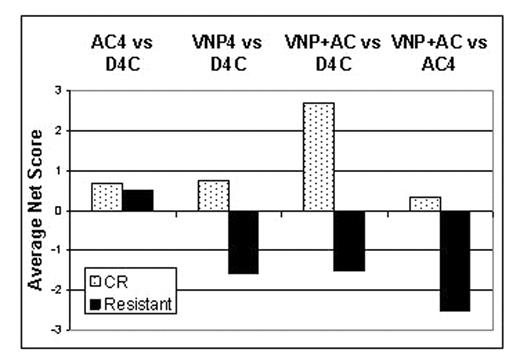In previous research we have demonstrated that the expression patterns of apoptosis regulating proteins (BCL2, Bax, PKCα, ERK2 and phosphoERK2) from cells that survive in vitro exposure to chemotherapy (Survivor Cells) differ substantially from the bulk population of cells present at diagnosis, and that these patterns are predictive of response to therapy and survival. To test whether this could be used to identify which patients would respond to novel therapies the expression profile in survivor cells treated in vitro with the combination of VNP40101M and Ara-C was correlated with outcome of 20 relapsed or refractory AML patients concurrently treated on a phase I-II protocol with Ara-C (1.5g/M2/D IVCI days 1–4) and VNP40101M(dose ranging from 200–600 mg/M2 on Day 2). There were 4 complete remissions among these 20 patients. Cells were exposed, alone or in combination, to 10 μg/ml of Ara-C and 200 μg/ml x1 or 50 μg/ml daily x4 of VNP-40101M. The percentage of surviving cells at 4 days was lower with the combination of ara-C +200μMx1 (6.7%) or +50μMx4 (11.4%) compared to single agent ara-C (17.7%) or VNP at 200μMx1 (11.5%) or 50μM (17.4%). Protein expression was measured after 4 days in all cases and also at 4 hours in 3 cases. Changes observed at 4 days were present by 4 hours in most cases (58%, 79%, 83%, 71% 67% for BCL2, Bax, PKCα, ERK2 and phosphoERK2 respectively). Early changes were frequently observed in pERK at 4 hrs that were lost by 4 days. Changes in Bax expression were often absent at 4 hrs but present at 4 days. A net apoptotic change score was calculated giving +1 point for increases in BCL2, PKCα, ERK2 and phosphoERK2 or decreased Bax and -1 point for the opposite. In this largely ara-C refractory population, the net score for the comparison of the Day 4 ara-C treated cells (D4A) compared to the Day 4 control cells (D4C) was uninformative with respect to response. In contrast the score of VNP treated cells was highly informative for response with patients that achieved CR having average scores significantly higher than non-responders when the results from day 4 VNP treated cells were compared to D4C (+ .75 vs. −1.6, p=0.06), or Day 4 VNP + ara-C treated cells were compared to D4C (+2.67 vs. −1.5, p=0.002) or D4A cells (+.33 vs. −2.2, p= 0.004). For this very small dataset the comparison of Day 4 VNP+AC treated cells with D4C cells had a sensitivity of 100%, a specificity of 71%, a positive predictive value of 50% and a negative predictive value of 100% for remission attainment. Analysis of a larger set of proteins analyzed would likely improve the sensitivity and specificity. This suggests that analysis of protein expression patterns in cells that survive in vitro chemotherapy can be utilized to identify cohorts of patients that are most likely to benefit from novel therapies. This strategy could be utilized to individualize treatment approaches for AML patients, and possibly to screen new agents or combinations of agents for potential activity in AML.
Corresponding author


This feature is available to Subscribers Only
Sign In or Create an Account Close Modal